Irrigation Analysis Based on Long-Term Weather Data
Abstract
:1. Introduction
2. Materials and Methods
2.1. Study Area and Irrigation Practices
2.2. Usefulness of an ET-Based Irrigation Management System
2.3. Calculation of Cotton ET (ETc)
2.4. Calculation of Irrigation Demand
2.5. Calculation of Irrigation Response
2.6. Analysis of Irrigation Demand/Irrigation Response Pair Usefulness
3. Results and Discussion
3.1. Seasonal ETc Patterns for the 30-Year Period
3.2. Role of ETc-Based Irrigation to Prevent Over-irrigation
3.3. Usefulness of ETc-Based Irrigation in the Absence of Over-irrigation
3.4. Frequency of Variable-Amount Irrigations Events
3.5. Amounts of Water Associated with Variable-Amount Irrigations
3.6. Reduced Usefulness of ETc-Based Irrigation at Low Well Capacities
3.7. Value of Historic vs. Real-Time ETc Values in Irrigation Management
4. Conclusions
Acknowledgments
Author Contributions
Conflicts of Interest
Abbreviations
| CV | coefficient of variation |
| DOY | day of year |
| ET | crop evapotranspiration (mm·day−1) |
| ETc | cotton ET (mm·day−1) |
| ETsz | standardized reference ET (mm·day−1) |
| ETos | ETsz for a short crop (mm·day−1) |
| ETrs | ETsz for a tall crop (mm·day−1) |
| Kc | crop coefficient |
| LEPA | low energy precision application |
| SE | standard error |
| THP | Texas High Plains |
References
- Hecht, A.D. Drought in the Great Plains: History of societal response. J. Clim. Appl. Meteorol. 1983, 22, 51–56. [Google Scholar] [CrossRef]
- Changnon, S.A.; Lamb, P.J.; Hubbard, K.G. Regional climate centers: New institutions for climate service and climate-impact research. Bull. Am. Meteorol. Soc. 1990, 71, 527–537. [Google Scholar] [CrossRef]
- Meyer, S.J.; Hubbard, K.G. Nonfederal automated weather stations and networks in the United States and Canada: A preliminary survey. Bull. Am. Meteorol. Soc. 1992, 73, 449–457. [Google Scholar] [CrossRef]
- Elliott, R.L.; Hubbard, K.G.; Brusberg, M.D.; Hattendorf, M.J.; Howell, T.A.; Marek, T.H.; Snyder, R.L. The role of automated weather networks in providing evapotranspiration estimates. In National Irrigation Symposium, Proceedings of the 4th Decennial Symposium, Phoenix, AZ, USA, 14–16 November 2000; pp. 243–250.
- Howell, T.A.; Meek, D.W.; Phene, C.J.; Davis, K.R.; McCormick, R.L. Automated weather data collection for research on irrigation scheduling. Trans. ASAE 1984, 27, 386–391. [Google Scholar] [CrossRef]
- Curry, R.B.; Klink, J.C.; Holman, J.R.; Elwell, D.L.; Sciarini, M.J. Current Ohio experience with an automated weather station network. Appl. Eng. Agric. 1988, 4, 150–155. [Google Scholar] [CrossRef]
- Elwell, D.L.; Klink, J.C.; Holman, J.R.; Sciarini, M.J. Ongoing experience with Ohio’s automatic weather station network. Appl. Eng. Agric. 1993, 9, 437–441. [Google Scholar] [CrossRef]
- Hoogenboom, G. The Georgia automated environmental monitoring network. In Proceedings of the 1993 Georgia Water Resources Conference, Athens, GA, USA, 20–21 April 1993; Hatcher, K.J., Ed.; Institute of Natural Resources: Concord, CA, USA, 1993; pp. 398–402. [Google Scholar]
- Brock, F.V.; Crawford, K.C.; Elliott, R.L.; Cupercus, G.W.; Stadler, S.J.; Johnson, H.L.; Eilts, M.D. The Oklahoma Mesonet: A technical overview. J. Atmos. Ocean. Technol. 1995, 12, 5–19. [Google Scholar] [CrossRef]
- Schroeder, J.L.; Burgett, W.S.; Haynie, K.B.; Sonmez, I.; Swirka, G.D.; Doggett, A.L.; Lipe, J.W. The West Texas Mesonet: A technical overview. J. Atmos. Ocean. Technol. 2005, 22, 211–222. [Google Scholar] [CrossRef]
- Pierce, F.J.; Elliott, T.V. Regional and on-farm wireless sensor networks for agricultural systems in eastern Washington. Comput. Electron. Agric. 2008, 61, 32–43. [Google Scholar] [CrossRef]
- Stewart, J.I.; Hash, C.T. Impact of weather analysis on agricultural production and planning decisions for the semiarid areas of Kenya. J. Appl. Meteorol. 1982, 21, 477–494. [Google Scholar] [CrossRef]
- Zhang, Y.; Leuning, R.; Chiew, F.H.S.; Wang, E.; Zhang, L.; Liu, C.; Sun, F.; Peel, M.C.; Shen, Y.; Jung, M. Decadal trends in evaporation from global energy and water balances. J. Hydrometeorol. 2012, 13, 379–391. [Google Scholar] [CrossRef]
- Vanderlinden, K.; Giráldez, J.V.; Meirvenne, M.V. Assessing reference evapotranspiration by the Hargreaves method in Southern Spain. J. Irrig. Drain. Eng. 2004, 130, 184–191. [Google Scholar] [CrossRef]
- Arneson, E.P. Early irrigation in Texas. Southwest. Hist. Q. 1921, 25, 121–130. [Google Scholar]
- Bloodworth, M.E.; Gillett, P.T. IRRIGATION—Handbook of Texas Online; Texas State Historical Association: Austin, TX, USA, 1984; Available online: http://www.tshaonline.org/handbook/online/articles/ahi01 (accessed on 20 June 2016).
- Hutchins, W.A. The community acequia: Its origin and development. Southwest. Hist. Q. 1928, 31, 261–284. [Google Scholar]
- Green, D.E. Land of the Underground Rain: Irrigation on the Texas High Plains, 1910–1970; University of Texas Press: Austin, TX, USA, 1973; p. 326. [Google Scholar]
- Musick, J.T.; Pringle, F.B.; Walker, J.J. Sprinkler and furrow irrigation trends: Texas High Plains. Appl. Eng. Agric. 1988, 4, 46–52. [Google Scholar] [CrossRef]
- Opie, J. Ogallala—Water for a Dry Land, 2nd ed.; University of Nebraska Press: Lincoln, NE, USA, 2000; p. 475. [Google Scholar]
- Colaizzi, P.D.; Gowda, P.H.; Marek, T.H.; Porter, D.O. Irrigation in the Texas High Plains: A brief history and potential reductions in demand. Irrig. Drain. 2009, 58, 257–274. [Google Scholar] [CrossRef]
- Musick, J.T.; Pringle, F.B.; Harman, W.L.; Stewart, B.A. Long-term irrigation trends: Texas High Plains. Appl. Eng. Agric. 1990, 6, 717–724. [Google Scholar] [CrossRef]
- Scanlon, B.R.; Faunt, C.C.; Longuevergne, L.; Reedy, R.C.; Alley, W.M.; McGuire, V.L.; McMahon, P.B. Groundwater depletion and sustainability of irrigation in the US High Plains and Central Valley. Proc. Natl. Acad. Sci. USA 2012, 109, 9320–9325. [Google Scholar] [CrossRef] [PubMed]
- English, M.J.; Musick, J.T.; Murty, V.V.N. Deficit irrigation. In Management of Farm Irrigation Systems; Hoffman, G.J., Howell, T.A., Solomon, K.H., Eds.; American Society of Agricultural Engineers: Saint Joseph, MI, USA, 1990; pp. 631–663. [Google Scholar]
- Fereres, E.; Soriano, M.A. Deficit irrigation for reducing agricultural water use. J. Exp. Bot. 2007, 58, 147–159. [Google Scholar] [CrossRef] [PubMed]
- Lyle, W.M.; Bordovsky, J.P. Low energy precision application (LEPA) irrigation system. Trans. ASAE 1981, 24, 1241–1245. [Google Scholar] [CrossRef]
- Lyle, W.M.; Bordovsky, J.P. LEPA irrigation system evaluation. Trans. ASAE 1983, 26, 776–781. [Google Scholar] [CrossRef]
- Bordovsky, J.P.; Lyle, W.M.; Lascano, R.J.; Upchurch, D.R. Cotton irrigation management with LEPA systems. Trans. ASAE 1992, 35, 879–884. [Google Scholar] [CrossRef]
- Lascano, R.J. A general system to measure and calculate daily crop water use. Agron. J. 2000, 92, 821–832. [Google Scholar] [CrossRef]
- Camp, C.R. Subsurface drip irrigation: A review. Trans. ASABE 1998, 41, 1353–1367. [Google Scholar] [CrossRef]
- Jensen, M.E. Water consumption by agricultural plants. In Water Deficits in Plant Growth; Kozlowski, T.T., Ed.; Academic Press: New York, NY, USA, 1968; Volume II, pp. 1–22. [Google Scholar]
- Allen, R.G.; Pereira, L.S.; Raes, D.; Smith, M. FAO—Irrigation and Drainage Paper, No. 56, Crop Evapotranspiration; FAO—Food and Agriculture Organization of the United Nations: Rome, Italy, 1998; p. 326. [Google Scholar]
- Allen, R.G.; Walter, I.A.; Elliott, R.; Howell, T.A.; Itenfisu, D.; Jensen, M.E. The ASCE Standardized Reference Evapotranspiration Equation; ASCE-EWRI Task Committee Report; American Society of Civil Engineers: Reston, VA, USA, 2005. [Google Scholar]
- Saturated Thickness 2004. Available online: http://www.depts.ttu.edu/geospatial/center/Ogallala/MapSeries/PDFs/03_SatThickness_8x11.pdf (accessed on 25 August 2016).
- Marek, T.; Howell, T.A.; New, L.; Bean, B.; Dusek, D.; Michels, G.J. Texas North Plains PET Network. In Proceedings of the International Conference Evapotranspiration and Irrigation Scheduling, San Antonio, TX, USA, 3–6 November 1996; Camp, C.R., Sadler, E.J., Yoder, R.E., Eds.; American Society of Agricultural Engineers: San Antonio, TX, USA, 1996; pp. 710–715. [Google Scholar]
- Winkler, R.L.; Murphy, A.H.; Katz, R.W. The value of climate information: A decision-analytic approach. J. Climatol. 1983, 3, 187–197. [Google Scholar] [CrossRef]
- Jagtap, S.S.; Jones, J.W.; Hildebrand, P.; Letson, D.; O’Brien, J.J.; Podesta, G.; Zierdend, D.; Zazueta, F. Responding to stakeholder’s demands for climate information: From research to applications in Florida. Agric. Syst. 2002, 74, 415–430. [Google Scholar] [CrossRef]
- Artikov, I.; Hoffman, S.J.; Lynne, G.D.; Pytlik Zillig, L.M.; Hu, Q.; Tomkins, A.J.; Hubbard, K.G.; Hayes, M.J.; Waltman, W. Understanding the influence of climate forecasts on farmer decisions as planned behavior. J. Appl. Meteorol. Clim. 2006, 45, 1202–1214. [Google Scholar] [CrossRef]
- Klockow, K.E.; McPherson, R.A.; Sutter, D.S. On the economic nature of crop production decisions using the Oklahoma mesonet. Weather Clim. Soc. 2010, 2, 224–236. [Google Scholar] [CrossRef]
- Carlson, J.D. The importance of agricultural weather information: A Michigan survey. Bull. Am. Meteorol. Soc. 1989, 70, 366–380. [Google Scholar] [CrossRef]
- Seeley, M.W. The future of serving agriculture with weather/climate information and forecasting: Some indications and observations. Agric. For. Meteorol. 1994, 69, 47–59. [Google Scholar] [CrossRef]
- Bolson, J.; Broad, K. Early adoption of climate information: Lessons learned from south Florida water resource management. Weather Clim. Soc. 2013, 5, 266–281. [Google Scholar] [CrossRef]
- Vining, K.C.; Pope, C.A., III; Dugas, W.A., Jr. Usefulness of weather information to Texas agricultural producers. Bull. Am. Meteorol. Soc. 1984, 12, 1316–1319. [Google Scholar] [CrossRef]
- Kenkel, P.L.; Norris, P.E. Agricultural producers’ willingness to pay for real-time mesoscale weather information. J. Agric. Resour. Econ. 1995, 20, 356–372. [Google Scholar]
- Irmak, S.; Rees, J.M.; Zoubek, G.L.; Van DeWalle, B.S.; Rathje, W.R.; DeBuhr, R.; Leininger, D.; Siekman, D.D.; Schneider, J.W.; Christiansen, A.P. Nebraska Agricultural Water Management Demonstration Network (NAWMDN): Integrating research and extension/outreach. Appl. Eng. Agric. 2010, 26, 599–613. [Google Scholar] [CrossRef]
- Mayer, P.; DeOreo, W.; Hayden, M.; Davis, R.; Caldwell, E.; Miller, T.; Bickel, P. Evaluation of California Weather-Based “Smart” Irrigation Controller Programs; Water Engineering and Management: Boulder, CO, USA, 2009. [Google Scholar]
- Zilberman, D.; Dinar, A.; MacDougall, N.; Khanna, M.; Brown, C.; Castillo, F. Individual and Institutional Responses to Drought: The Case of California Agriculture; Working Paper; Department of Agricultural & Resource Economics, University of California: Berkeley, CA, USA, 1995. [Google Scholar]
- Farahani, H.J.; Howell, T.A.; Shuttleworth, W.J.; Bausch, W.C. Evapotranspiration: Progress in measurement and modeling in agriculture. Trans. ASABE 2007, 50, 1627–1638. [Google Scholar] [CrossRef]
- Strzepek, K.; Boehlert, B. Competition for water for the food system. Philos. Trans. R. Soc. B 2010, 365, 2927–2940. [Google Scholar] [CrossRef] [PubMed]
- LaRue, J.; Yonts, C.D. Irrigation water supply. In Irrigation, 6th ed.; Stetson, L.E., Mecham, B.Q., Eds.; Irrigation Association: Falls Church, VA, USA, 2011; pp. 173–214. [Google Scholar]
- Sneed, R.E.; Allen, R.G. Hydraulics of irrigation systems. In Irrigation, 6th ed.; Stetson, L.E., Mecham, B.Q., Eds.; Irrigation Association: Falls Church, VA, USA, 2011; pp. 215–270. [Google Scholar]
- Mauget, S.; Leiker, G. The Ogallala agro-climate tool. Comput. Electron. Agric. 2010, 74, 155–162. [Google Scholar] [CrossRef]
- Mahan, J.R.; Young, A.W.; Payton, P. Deficit irrigation in a production setting: Canopy temperature as an adjunct to ET estimates. Irrig. Sci. 2011, 30, 127–137. [Google Scholar] [CrossRef]
- Davis, J.C. Statistics and Data Analysis in Geology, 3rd ed.; John Wiley & Sons, Inc.: New York, NY, USA, 2002; p. 638. [Google Scholar]
- Wagner, K. Status and Trends of Irrigated Agriculture in Texas; Texas Water Resources Institute: College Station, TX, USA, 2012; p. 6. [Google Scholar]
- Lascano, R.J.; Van Bavel, C.H.M. Explicit and recursive calculation of potential and actual evapotranspiration. Agron. J. 2007, 99, 585–590. [Google Scholar] [CrossRef]
- Lascano, R.J.; Van Bavel, C.H.M.; Evett, S.R. A field test of recursive calculation of crop evapotranspiration. Trans. ASABE 2010, 53, 1117–1126. [Google Scholar] [CrossRef]
- Orgaz, F.; Testi, L.; Villalobos, F.J.; Fereres, E. Water requirements of olive orchards–II: Determination of crop coefficients for irrigation scheduling. Irrig. Sci. 2006, 24, 77–84. [Google Scholar] [CrossRef]
- Suleiman, A.A.; Tojo Soler, C.M.; Hoogenboom, G. Determining FAO-56 crop coefficients for peanut under different water stress levels. Irrig. Sci. 2013, 31, 169–178. [Google Scholar] [CrossRef]
- Sánchez, J.M.; Lopez-Urrea, R.; Doña, C.; Caselles, V.; Gonzalez-Piqueras, J.; Niclòs, R. Modeling evapotranspiration in a spring wheat from thermal radiometry: Crop coefficients and E/T partitioning. Irrig. Sci. 2015, 33, 399–410. [Google Scholar] [CrossRef]
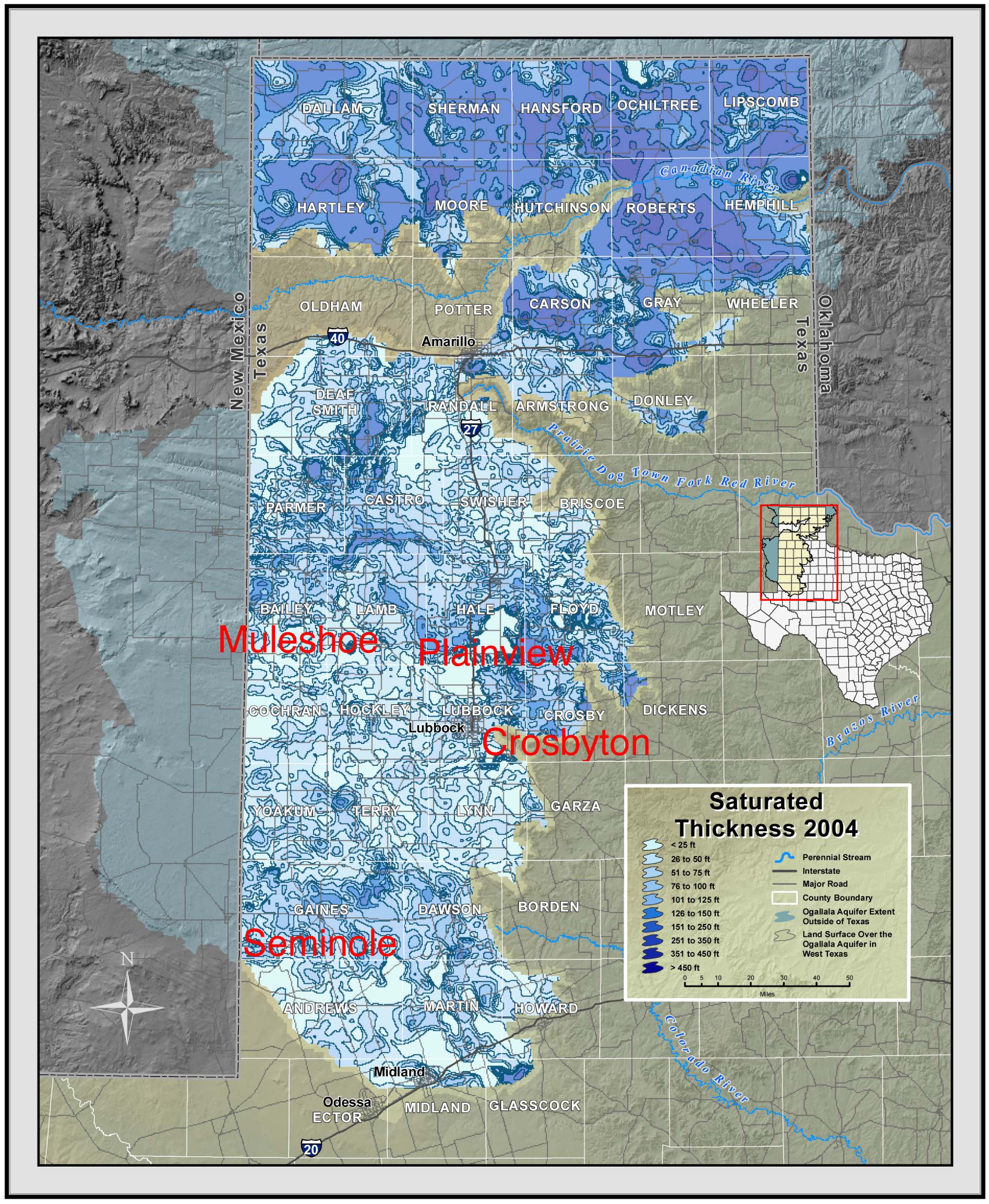

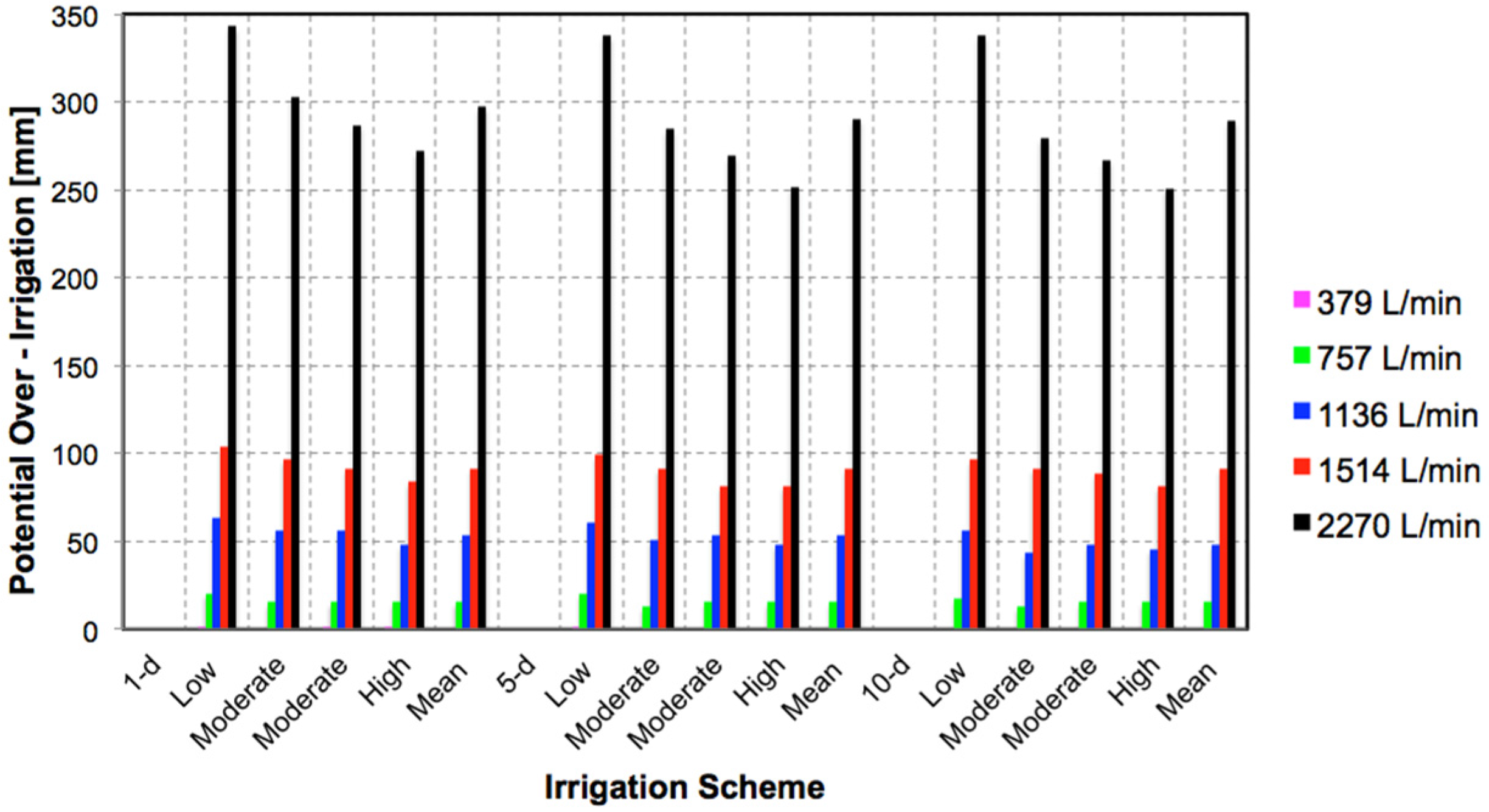
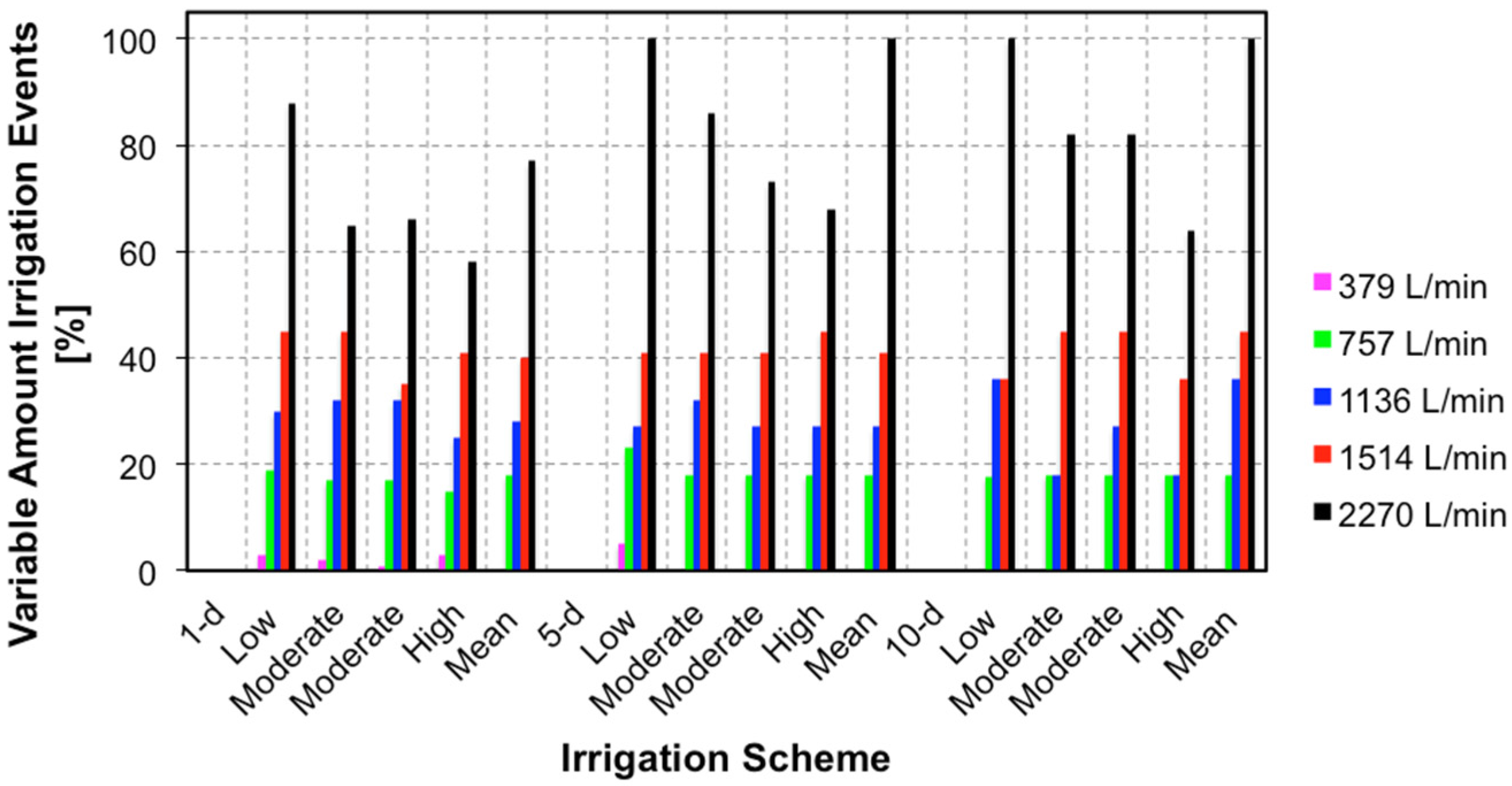
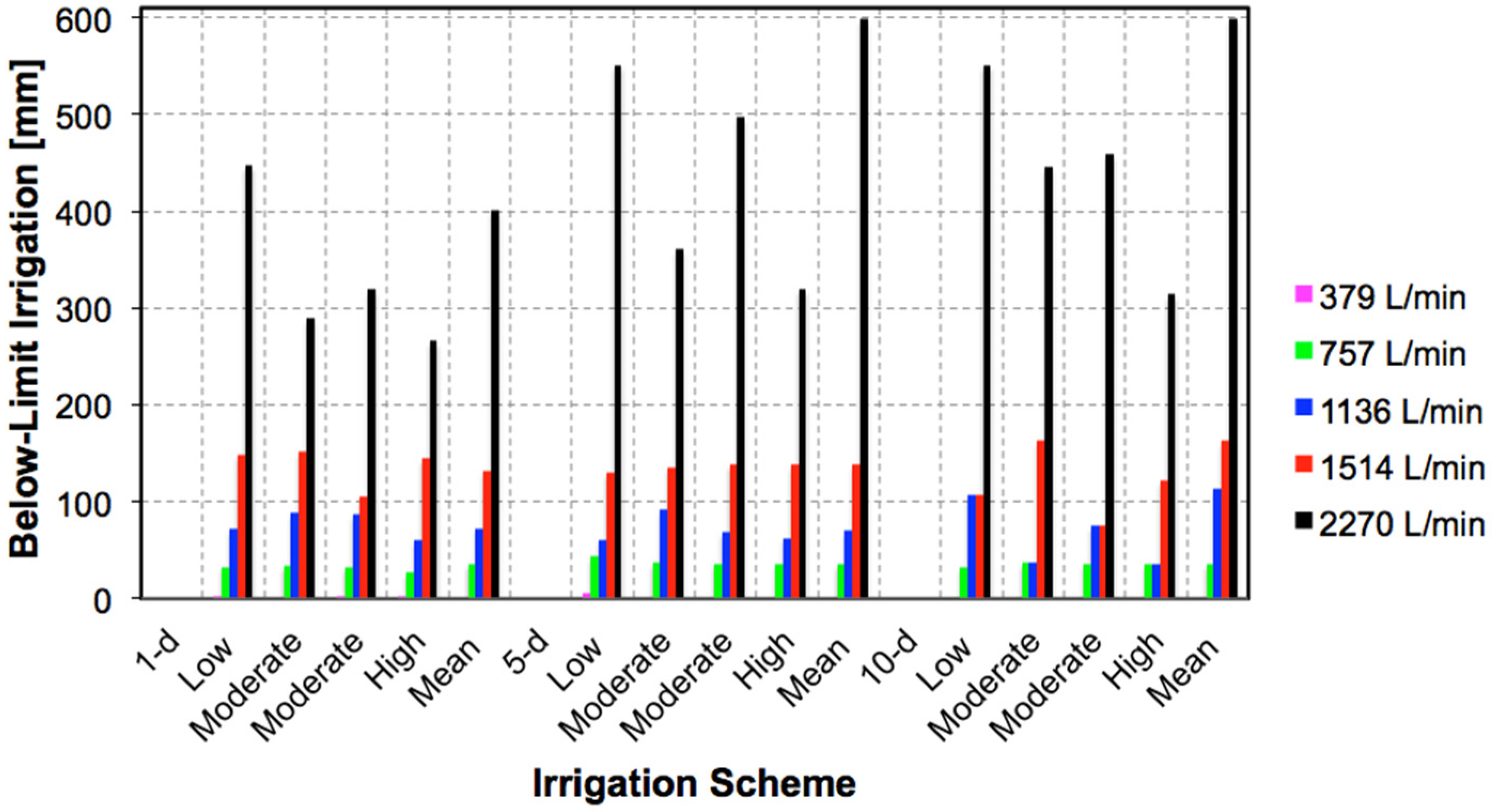
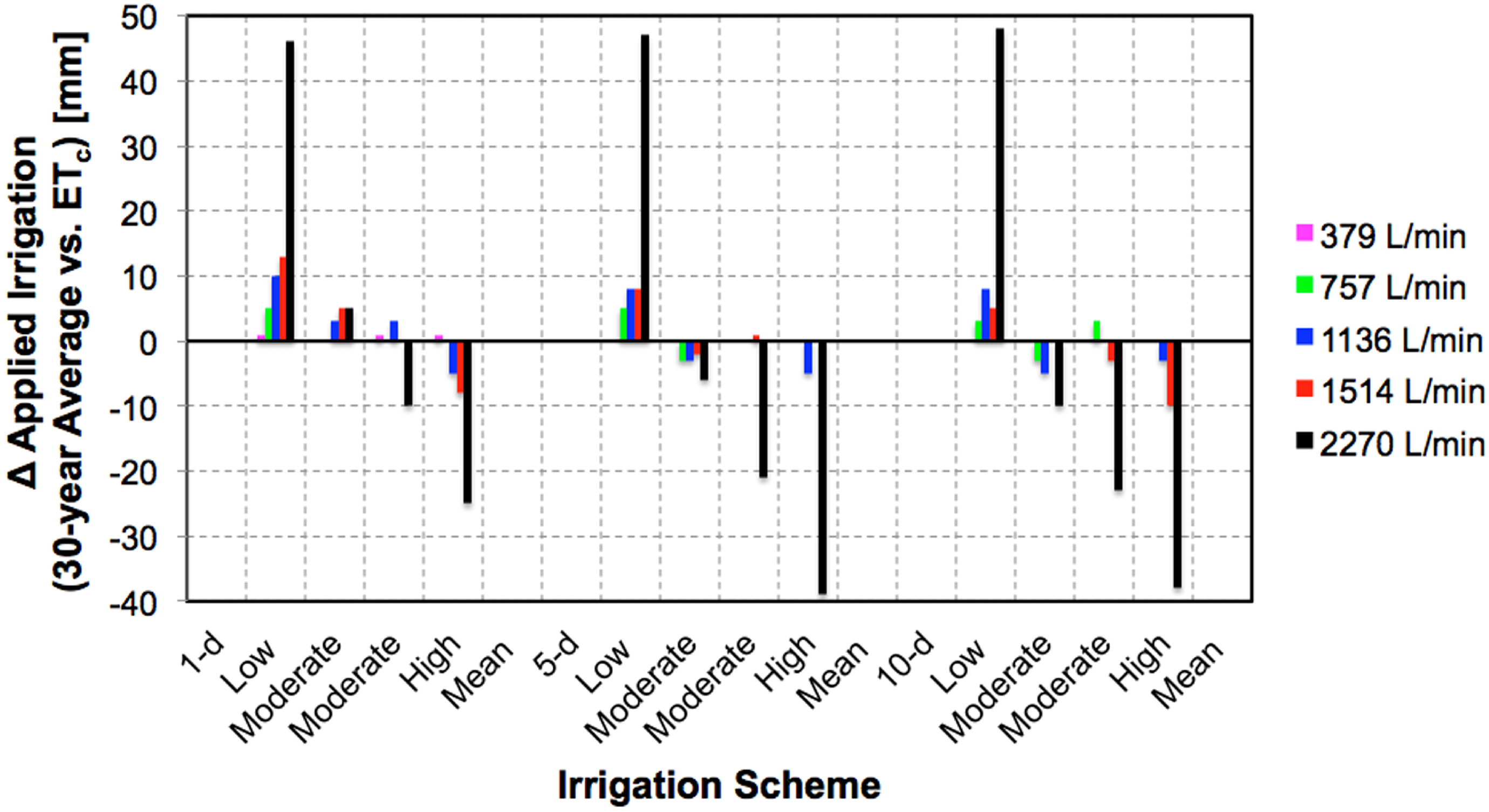
| Irrigation Interval (days) | Well Capacity * (mm·day−1) | Well Capacity (L·min−1) | Maximum Water Available # (mm) |
|---|---|---|---|
| 1 | 1.3 | 370 | 1.3 |
| 2.5 | 712 | 2.5 | |
| 4.1 | 1167 | 4.1 | |
| 5.1 | 1452 | 5.1 | |
| 7.6 | 2164 | 7.6 | |
| 5 | 1.3 | 370 | 6.5 |
| 2.5 | 712 | 12.5 | |
| 4.1 | 1167 | 20 | |
| 5.1 | 1452 | 25.5 | |
| 7.6 | 2164 | 38 | |
| 10 | 1.3 | 370 | 13 |
| 2.5 | 712 | 25 | |
| 4.1 | 1167 | 41 | |
| 5.1 | 1452 | 51 | |
| 7.6 | 2164 | 76 |
| Statistical Parameter ETc | Moments of the Mean | Unit | Muleshoe | Seminole | Crosbyton | Plainview |
|---|---|---|---|---|---|---|
| Minimum | mm·day−1 | 0.0 | 0.0 | 0.0 | 0.0 | |
| Maximum | mm·day−1 | 8.6 | 8.7 | 8.2 | 8.2 | |
| Points/Year | 110 | 110 | 110 | 110 | ||
| CV | % | 44.3 | 44.8 | 41.4 | 43.0 | |
| SE | 0.24 | 0.24 | 0.22 | 0.22 | ||
| Mode | mm·day−1 | 8.0 | 1.4 | 7.8 | 1.6 | |
| Median | 6.1 | 6.2 | 5.9 | 5.9 | ||
| Mean | mm·day−1 | 5.6 | 5.6 | 5.5 | 5.4 | |
| Variance | 6.1 | 6.3 | 5.5 | 5.4 | ||
| Skewness | −0.51 | −0.55 | −0.48 | −0.49 | ||
| Kurtosis | −1.09 | −1.06 | −1.1 | −1.12 | ||
| Shapiro-Wilk | 0.89 | 0.89 | 0.89 | 0.89 | ||
| p-value | 1.7 × 10−7 | 1.2 × 10−7 | 2.4 × 10−7 | 2.2 × 10−7 |
© 2016 by the authors; licensee MDPI, Basel, Switzerland. This article is an open access article distributed under the terms and conditions of the Creative Commons Attribution (CC-BY) license (http://creativecommons.org/licenses/by/4.0/).
Share and Cite
Mahan, J.R.; Lascano, R.J. Irrigation Analysis Based on Long-Term Weather Data. Agriculture 2016, 6, 42. https://doi.org/10.3390/agriculture6030042
Mahan JR, Lascano RJ. Irrigation Analysis Based on Long-Term Weather Data. Agriculture. 2016; 6(3):42. https://doi.org/10.3390/agriculture6030042
Chicago/Turabian StyleMahan, James R., and Robert J. Lascano. 2016. "Irrigation Analysis Based on Long-Term Weather Data" Agriculture 6, no. 3: 42. https://doi.org/10.3390/agriculture6030042
APA StyleMahan, J. R., & Lascano, R. J. (2016). Irrigation Analysis Based on Long-Term Weather Data. Agriculture, 6(3), 42. https://doi.org/10.3390/agriculture6030042






